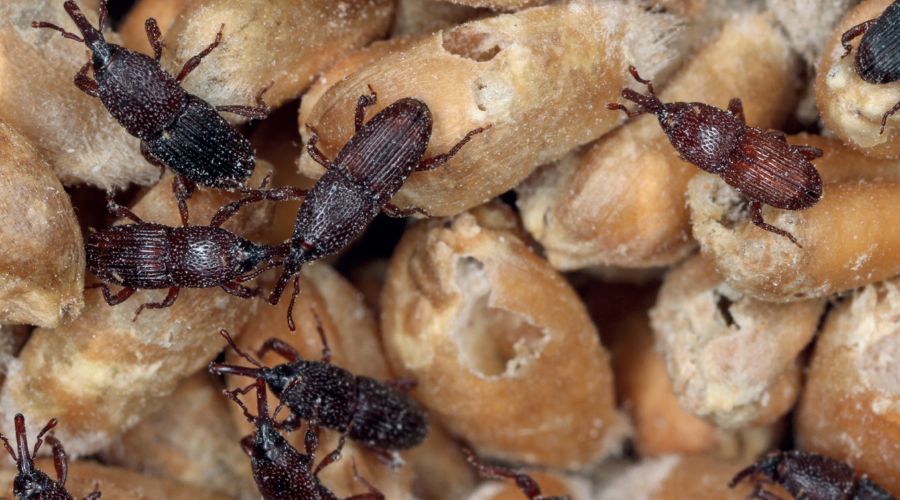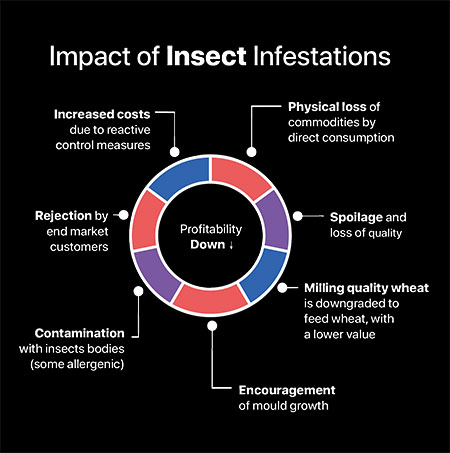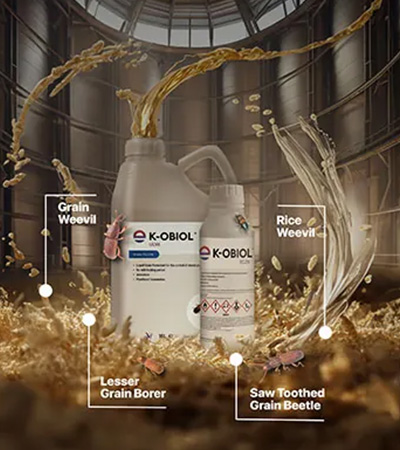How to eradicate grain store pests
13th May 2024
Preventing pests is easier than tackling an established infection, so it’s important to know your enemy, monitor for grain store pests regularly and treat where necessary using an IPM approach.

It’s a fact: 90% of farm grain stores harbour at least one species of insect known to destroy precious grain; yet, only 40% of growers use an insecticide to treat stores, or grain, to prevent devastating infestations from the most common insect pests.
One thing is certain this season: If steps aren’t taken to keep problem insect pests out of grain stores; they’ll move in on grain, infesting precious harvests and pinching profit.
As always, preventing grain store pests is always easier than tackling an established infestation, says Ken Black, Envu account manager.
Early detection is key to prevent rising populations and limit damage to grain, so monitoring for changes in temperature and identifying ‘hotspots’ is recommended – more activity means more heat, and more heat means more damage.
Know your enemy
“Insect pests don’t enter stores from the field during harvest,” Ken explains.
“Instead, they lie dormant on ledges or in cracks in the store; and can be brought in on machinery or people, or on transport delivering or collecting from the farm.”
Insect pests that threaten grain are divided in to three main groups depending on their diet, environment and behaviour.
Primary insect pests like grain weevil, and saw-toothed grain beetle, damage grain while raising temperature and moisture levels, creating suitable conditions for secondary insect pests and fungi.
Secondary insect pests including the Australian spider beetle and stored product moths, develop on grain damaged by primary insects, or from physical or biological action; or, on previously infested, mouldy grain.
Class three pests include mites – a serious problem in stored cereals and oilseed rape, causing direct damage, taint and, in large numbers, allergic reactions in humans and livestock.
An effective strategy
Pest control starts well before any grain arrives. Thorough cleaning of empty stores is vital, but is still not enough in isolation. Effective strategies rely on integrated pest management (IPM).
IPM provides a program of prevention, monitoring and control strategies to limit pest damage by the most economical means possible and with the least environmental impact. A well-planned IPM strategy incorporates good hygiene, monitoring, and control with chemical treatments.
After grain arrives, weekly monitoring means problems can be detected early, and that control may be possible using a combination of cooling, cleaning, or drying.
The presence of grain store pests should be continually monitored using a combination of floor and pit fall traps, as these give a good indication of potential insect populations within the store.
“Pit fall traps, insect monitoring traps or nut-free bait bags are all effective ways to assess insect activity,” he says.
“Traps should be placed at regular intervals within the building, both on ledges and walls and on the surface of the grain to target different pest species.
“Check them weekly until the grain reaches the target temperature of 50ºC, and providing the grain remains at this temperature, monitor on a monthly basis. In the spring, when temperatures rise and insects become active once again, revert to weekly monitoring.”
Ken adds: “It’s also important to monitor temperature and moisture levels, ideally keeping stores below 13°C and 14.5% moisture for cereals and 7-8% for oilseed rape.”
Preventative and curative protection
If chemical control is needed, K-Obiol offers “unrivalled efficacy” against the most common insect pests. It is available in two formulations – both provide preventative and curative protection – which can be applied to the grain post-harvest and will prevent damage for up to 12 months.
Used as part of an IPM approach, K-Obiol will provide the highest level of protection for valuable stored grain, Ken says.
K-Obiol is approved for use on all cereal grains including wheat, barley, maize, rice, oats and triticale and is accepted for use by the Brewing Research International (BRI), the National Association of British and Irish Millers (NABIM) and the Trade Assurance Scheme for Combinable Crops (TASCC).
When applied at its recommended rate, the residue level of K-Obiol is four times lower than the Maximum Residue Limit (MRL) for grain (0.25mg/kg).
It is a low odour formulation that has no effect on seed germination; and, as it has no withholding period, any grain treated with the product can be processed straight away.
To find out more about how K-Obiol can protect your harvest against grain store pests, visit the Lodi UK website or contact the pest solutions team on sales@lodi-uk.com or 01384 404242.
Read more arable news


